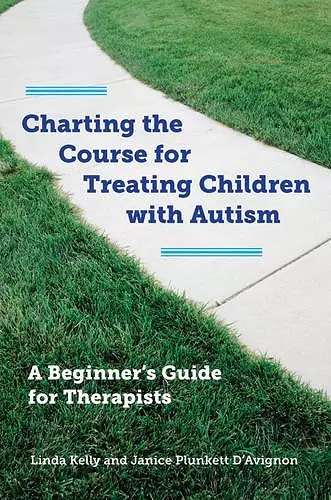Charting the Course for Treating Children with Autism
A Beginner's Guide for Therapists
Linda Kelly author Janice Plunkett D'Avignon author
Format:Hardback
Publisher:WW Norton & Co
Published:29th Apr '14
Currently unavailable, and unfortunately no date known when it will be back

Therapists play a crucial role in helping children and their families as they navigate the often stormy course of living with autism spectrum disorders (ASD). As cases of autism are increasingly diagnosed, the number of therapists with specialized training cannot keep pace. What is the clinician without prior experience with this disability to do when considering working with a child on the autism spectrum?
This “start here” book—a practical beginner’s guide to ASD for therapists—provides the answer. Without getting bogged down in the complexity of the disorder or attempting to turn practitioners into autism specialists, it points therapists—novices and seasoned alike—in the right direction so they’re better equipped to provide support.
Because autism can manifest in so many different ways, no cookie-cutter treatment exists and therapists need to be conversant with the basics, from assessment and treatment approaches to common therapeutic issues that can arise. This book serves as an invaluable road map.
Viewing ASD as a social communicative disorder, the authors provide a sound background of its manifestations and therapeutic interventions, helping therapists to define treatment issues and prepare for potentially difficult client encounters. Filled with practical insights and guidance, the book explains how to ask the right questions of parents and how to assess their answers. It presents a philosophy to guide parents and others in changing their perceptions of the child’s disability so as to pave the way for effective approaches to be used within the child’s environment. Concrete tools are provided to help determine “goodness of fit” between the therapist and client, in addition to several helpful reproducible intake and assessment forms available for download on an accompanying CD.
Charting the Course is an important therapist’s guide representing an all-encompassing approach to working not only with children and their parents, but also with their siblings, family members, and those in the community who are involved in their lives. Ultimately, this book provides a reassuring anchor for any clinician new to treating this disability as well as for those who are seeking alternative approaches to their ongoing work with children diagnosed with ASD.
"When a therapist gets lots in the details of a family interview, everyone begins to feel overwhelmed, maybe even confused. Having a book that outlines necessary steps is a saving grace. If you are a therapist who needs help with interviewing the family, conducting a sound assessment, developing a treatment plan, interviewing the child, and setting boundaries, objectives, and future goals, this book is for you. Working with children on the spectrum takes a lot of patience and experience, and Kelly and Plunkett D’Avignon can help you prepare." -- PsychCentral
"[A]n extremely helpful new book . . . [V]ery useful for parents, caregivers and educators in understanding the actions of children on the autism spectrum." -- Parenting Press Newsletter
"Therapists entering the world of autism need a clear and accurate guide to understanding children who, at times, seem to belong to a different culture. The explanations and advice provided by Kelly and D’Avignon are based on their considerable experience, wisdom, and thorough review of the literature. Therapists from a range of disciplines—new to the world of autism, as well as seasoned travelers such as myself—will gain knowledge and insight, both valuable and enjoyable." -- Tony Attwood, PhD, Chairperson, The Minds and Hearts Clinic, Brisbane, Australia; author of The Complete Guide to Asperger's Syndrome
"A marvelous book both for beginning therapists and experienced ones, this volume provides a readable, highly useful introduction to intervention in autism. With chapters speaking to students, parents, and siblings, the book provides a thoughtful approach to developing a treatment plan as well as preparing for the future. It will be an invaluable guide for years to come." -- Fred R. Volkmar, MD, Chief of Child Psychiatry at Yale New Haven Hospital; Editor-in-Chief, Journal of Autism and Developmental Disorders
"A practical outline for working with a high functioning autistic person that clearly spells out the differences required in employing a therapeutic process that fits both their general profile and their particular individual needs. Both new and seasoned therapists can learn a lot from this book. The forms fit the theory. Use them!" -- Elsa Abele, CCC, SLP, Pragmatic Language Consultant; Associate, Center for Autism Spectrum Disorders, Antioch University NE
"The community of psychotherapists working with clients with autism spectrum disorder is fortunate that this book has been written. In careful step-by-step explanations, readers are led through explanations of terms, causes of the disorder, and recommendations for its remediation. Avoiding the thickets of medical terminology that have plagued earlier works, this book strikes straight to the heart of the matter. Of particular value are the 12 exemplars of agreements, forms, and checklists found in the appendices. If a part of your practice involves treating ASD, this is the book for you." -- John Dacey, PhD, Professor Emeritus, Boston College; author of Human Development Across the Lifespan and Your Anxious Child
ISBN: 9780393708714
Dimensions: 262mm x 213mm x 28mm
Weight: 841g
288 pages